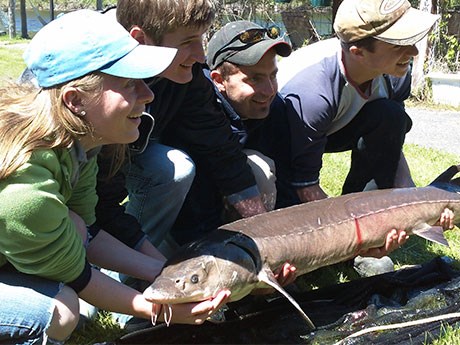Fish dates back to the dinosaur age and can live more than 100 years
Two mining companies with operations in the Timmins area – Xstrata Copper and Lake Shore Gold – are helping to restore as prehistoric fish species to a part of the Mattagami River that runs through the city.
Lake sturgeon, which date back to the dinosaur age, have been designated by the Ontario Ministry of Natural Resources as a species of “special concern” in the southern Hudson Bay drainage basin as a result of overfishing and habitat degradation caused by logging activity and the damming of the river for hydroelectric power generation.
Dave Yaschyshyn, superintendent of environment for Xstrata Copper’s Kidd Operations, read about the communitybased Mattagami Sturgeon Restoration Project in a local newspaper and decided to help out.
Natural fit
“I thought it would be an excellent project for Xstrata Copper to get involved with,” he said. “We had compiled an inventory of all the different species at risk around our operations in Timmins and the lake sturgeon was one of the species identified, so we figured it would be a natural fit for us.”
Lake sturgeon can weigh to 150 kilograms and live over 100 years, but they take their time to reach sexual maturity, reproducing only after the age of 15 for males and 25 for females, and then only every three or four years.
More populous in the northern stretch of the Mattagami, which empties into James Bay, lake sturgeon virtually disappeared from an area of the river between two dams north of Timmins.
In 2002, the Ministry of Natural Resources with assistance from Ontario Power Generation (OPG), a forest products company and two conservation groups (the Timmins Fur Council and Club Navigatuer) transferred 50 adult lake sturgeon from the northern part of the river to an area upstream of OPG’s Sandy Falls dam.
Of the 50 lake sturgeon, 13 were fitted with radio transmitters to track their movements and learn about their preferred habitat.
“Some of the adult fish went over the falls and ended up in the stretch downstream of Sandy Falls and started reproducing there,” said Yaschyshyn.
Anglers began reporting more and more catches in the area, so in 2010, a second netting and tracking initiative was proposed.
“That’s when we got involved,” said Yaschyshyn. Twenty more fish were fitted with radio transmitters between May 28 and June 9, 2011 thanks in part to financial and in-kind contributions by Xstrata Copper, and this past spring,
a helicopter contracted by the company for an environmental survey was used to track the movements of the fish along the river.
“The numbers are coming back for sure,” said Ministry biologist Derrick Romain. “People are catching them like crazy at the boat launches and throughout the system.”
There are three distinct populations of lake sturgeon in Ontario. The northwestern Ontario and Great Lakes/Upper St. Lawrence River populations were designated as threatened in September 2009, making it illegal to kill, harm, harass or capture them.
The Southern Hudson Bay/James Bay population in the Mattagami and other rivers was designated at the same time as being of “special concern,” and placed under a catch and release order.
Habitat restoration
Tracking the sturgeon using radio transmitters allows Ministry biologists to learn where they like to hang out and design habitat restoration measures to promote their growth and reproduction.
“Once we understand what’s drawing them to an area, maybe we can add some shoals to attract their prey,” said Romain.
Biologists can also analyze the composition of the river bottom in their preferred habitat by taking photographs and grab samples. Logging operations years ago probably contributed to the degradation of the lake sturgeon habitat, but not mining, said Yaschyshyn.
“That’s not what compelled us to get involved.”
Lake Shore Gold joined the community- based stewardship project earlier this year and has a special interest in monitoring the lake sturgeon population upstream of Sandy Falls, where discharge from the company’s Bell Creek complex empties into the Tatachikapika River, which in turn flows into the Mattagami.



